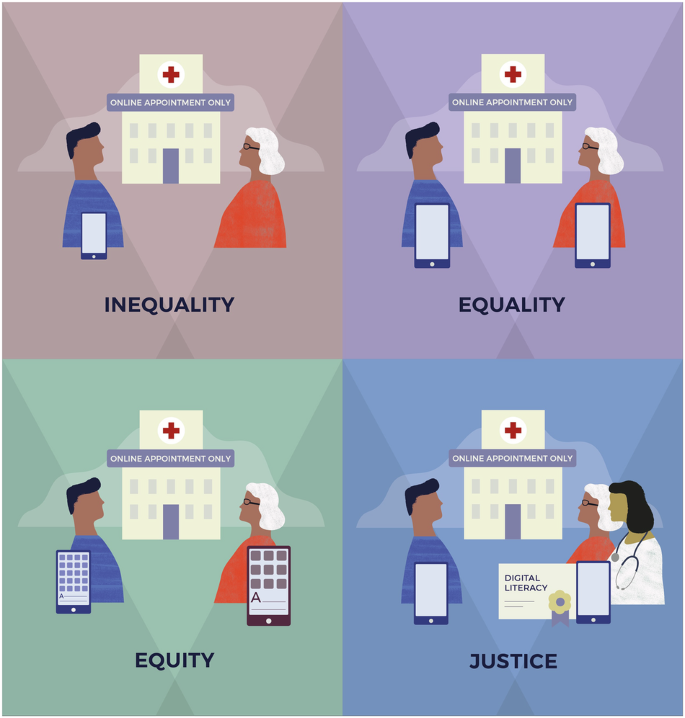Applying the principle of justice in digital health

The interpretation of those moral foundations into an organized lens requires to evaluate digital well being challenges. Relying on the precept of justice, we propose a working framework that has been tailored to evaluate digital well being interventions not solely when it comes to entry and ease of use, but additionally in tips on how to deal with common disciplines and improve complete innovation.
Justice in healthcare is to specific the concept of equal alternatives and apply the precept of distinction when sources are uncommon. The method of digital transformation that understands and acknowledges the restrictions imposed on a big a part of the inhabitants won’t endanger the precept of justice. The velocity of this transformation of the system in direction of digitization has a serious affect not solely on healthcare service customers but additionally on healthcare practitioners as properly.
Provided that well being insurance policies are often primarily based on distribution justice, we consider that it is very important apply this method within the subject of digital well being. Once we discuss organic ethics and digital well being, the precept of justice should lead us to assist the precept of equal alternatives within the distribution of advantages and burdens introduced by technological developments to society. However to correctly deal with justice, it isn’t adequate to observe the precept of equality, guaranteeing full entry to all of the units, procedures and laws associated to digital well being. In digital transformation, some inequality is inevitable in favor of those that can adapt extra shortly to a relentless change (this speedy adaptation could want to shift and its advantages). However the precept of justice should observe the precept of distinction, which requires us to make sure that these modifications as properly, particularly, profit from the “most disadvantaged”, that’s, the folks represented by this adaptation course of as an actual problem.
It’s one thing to permit the inhabitants digital units, and the opposite to make sure that the advantages of digital transformation. You will need to concentrate on the obstacles provided by a rising technological surroundings that places some customers in a big, and attempt to compensate for a place we can be proper to consider injustice.
On this context, then justice is to offer equal, honest and acceptable therapy. Anybody has an accurate situation for this therapy. Alternatively, injustice is an incorrect act or a neglect that deprives folks of the advantages which have the correct, or fail to distribute the burdens pretty.
We determined to adapt the picture of Tony Roth23 From the shares in digital well being and the assorted ideas related to the precept of justice to be able to spotlight the challenges that we should cope with if we actually intend to scale back the digital hole (form. 1).
An illustration mannequin tailored from the final well being rights frameworks, utilized to digital and inclusive entry. The form contrasts between the degrees of useful resource distribution and structural response: inequality (no arrival), equality (the identical entry whatever the want), shares (entry to particular person wants), and justice (elimination of structural boundaries and lively facilitation of integration).
In line with this air -conditioned picture, counting on the philosophical ideas of justice, equality and equity beforehand offered, we clarify how these ideas within the subject of digital well being could be defined:
InequalityThis means the conditions the place somebody can entry an web and an lively machine, whereas the opposite will not be. Within the context of digital well being, this inequality is very associated to techniques that more and more improve digital appointments and supply many companies by cell purposes and digital platforms. With out satisfactory assist, this shift could exclude massive sectors of the inhabitants who lacks arrival or digital abilities, thus undermining a good entry to well being care.
Equality: On this state of affairs, two persons are supplied with the identical digital machine and web connection. Though this appears to be equal therapy, it fails to calculate the precise wants. For instance, an individual with restricted digital literacy or visible weak point could not be capable to successfully use the machine, whereas somebody has a higher technological effectivity that will discover the identical sources inadequate. This explains how official equality alone can reproduce or exacerbate the variations.
justiceFairness consists of figuring out the variations within the capabilities and contexts of people, and taking proactive steps to make sure significant arrival. In digital well being, this will likely imply offering a bigger machine with an improved imaginative and prescient for a low -vision consumer, or assist for an individual with restricted expertise. Fairness requires sources for precise wants, as an alternative of assuming one resolution that fits everybody.
justiceJustice goes past particular person lodging and consists of structural work to eradicate the foundation causes of inequality and digital exclusion. This consists of investing in digital literacy applications for the weak inhabitants and the appointment of digital well being facilitators to assist sufferers in digital instruments and entry to a full vary of accessible companies. Such measures goal to create a good and complete wholesome ecosystem the place everybody can take part and profit.
We consider that this new picture responds to a brand new imaginative and prescient of justice and digital well being. In an article printed in 202424We talked concerning the necessary social and financial groups between individuals who have entry to new applied sciences and the talents wanted to make use of them and those that don’t do (digital hole).
Nevertheless, the digital hole a lot exceeds the variations in bilateral entry, because it acts as a multi -layer specified for well being outcomes which are shaped by the intersection of structural, cultural and technical forces. Modern analysis depicts this hole by the DDH lens25Which works throughout particular person, private, societal and societal ranges26.
The formal nature of those issues within the frameworks such because the framework of property rights for digital well being care, which integrates inventory evaluations by 5 levels of life cycle akin to planning, improvement, acquisition, implementation, and monitoring27. Its fundamental innovation lies within the hyperlink Technical design (For instance, algorithm audit operations for bias), Create a standard society (For instance, participatory preliminary fashions with marginalized customers), and Systemic empowerment components (For instance, coverage mandates for inter -employment). Ethically, the failure to determine these layers with layers, the dangers improve the structural injustice below the curtain of digital innovation. Furthermore, digital exclusion is commonly exacerbated by the insecurity of establishments, particularly amongst traditionally marginalized societies or topic to monitoring, which makes constructing confidence an necessary element of honest design.
On the whole, most of the people has a optimistic impression on digital well being28and29and30However solely a really small group derives the utmost profit from the chances it supplies3and31. A assessment printed in 202332 He pressured that enhancing digital literacy is important to makes an attempt to encourage most of the people to actively take part in choice -making and pay extra consideration to their well being.
Looking for methods to shut the digital hole is without doubt one of the essential challenges33 Dealing with digital well being within the quick time period. For the biggest half, the age group of greater than 70 years is the least susceptible to possessing the required technological abilities or figuring out instruments and digital units, as a result of solely 28.5 % of people between the ages of 65 and 74 within the European Union have fundamental or larger digital abilities, akin to the power to make use of good units akin to smartphones or computer systems34. This stage decreases dramatically from the age of 75, with solely 9.8 % in Spain or 4.6 % in Italy34. Furthermore, a examine carried out in 2023 for sufferers with diabetes over the age of 65 confirmed that 85 % had discovered helpful digital instruments, however there isn’t a greater than 35 % they already use it already.35.
This information highlights the necessity to course of this distance in order that digitization doesn’t grow to be an impediment to accessing a well being care system. Will probably be obligatory to consider conditions the place persons are extra in danger (attributable to an absence of coaching or lack of acceptable contact) so as to have the ability to present actual options. New applied sciences enable folks to seek the advice of well being practitioners shortly and straight with out the necessity to come to the well being heart; This capacity is in itself a type of justice, because it supplies equal alternatives for sufferers to obtain therapy from well being professionals when it is extremely troublesome in different conditions.
The present social and demographic actuality is unlikely to alter within the coming years. In actual fact, we consider that it’ll stay largely as it’s, as a result of inequality won’t disappear all of a sudden, and the pattern in direction of longevity will proceed. The aged and essentially the most susceptible members within the inhabitants are typically the primary customers of the well being system, and on the similar time those that are more likely to be excluded by digitization; Alternatively, the sectors of the youthful inhabitants or those that usually are not topic to the chance of social exclusion don’t face this drawback as a result of they’re both “digital residents” already or that they’ve been digitizing shortly lately.
Many inhabitants teams – together with older adults, disabled people, folks with low digital literacy, linguistic minorities, and those that have restricted financial social sources – are among the many essential customers of well being care companies and are at larger threat of exclusion in digital transformation. Digital well being insurance policies ought to make sure that these societies usually are not left behind. That’s the reason it is very important contain them in designing these digital insurance policies or, at the very least, taking their wants when planning to digitize the brand new digital well being system. Makes an attempt to entry the digital system should put extra pretty on the true opinions, experiences and wishes of this group of individuals of their each day relationships with well being companies.
The Covid-19 pandemic has made it clear this actuality, and the imposition of digitization in most areas of interplay between authorities companies and the general public, and maybe within the well being sector greater than wherever else. PandeMic Restricted’s pandemic entry to face and revenue in various patterns to offer well being care companies akin to on-line appointments, digital consultations, and a distant physician. All of those companies present necessary organizational or administrative benefits, however not everybody will see these modifications helpful. On this case, the precept of justice could also be critically undermined.
Digitization raises the problem of re -evaluating the scope of ethics in well being. The dilemmas raised by the suitable administration of enormous portions of well being information, the privateness of execs and sufferers, and guaranteeing honest entry to superior applied sciences and digital sources.
2025-07-21 20:28:00






